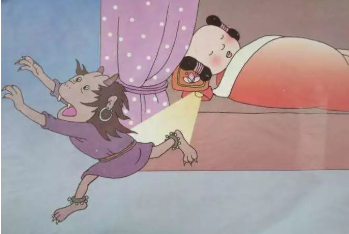Background: Green, Purple, or Red Protection?
- Red Envelopes on an iPhone
The Chinese tradition of gifting money to relatives during Chinese New Year transitioned into the digital era due to the actions of these companies. However, where did the tradition come from? And in what ways did this tradition spread?
The custom of giving money to relatives goes far back in China, as does the history of red envelopes. Money was and is a welcome gift for almost everyone, so this was also the case in China.
The earliest form of the red envelope is said to be yasuiqian 压祟钱. In Chinese history, there was the belief that putting money underneath children’s pillows during Chinese New Year would keep evil spirits away (Fig. 1).
The practice of using coins and rope for yasuiqian continued well into the Qing dynasty (1636-1912). Manchu writer Fuca Dunchong (1855-?):
Using a colorful rope money is woven to form a dragon shape, which is placed on the bottom of a bed. This is called yasuiqian.
As time went by and paper envelopes became more widespread, the tradition developed into coins being put into an envelope. The introduction of the red envelope was no surprise: red in Chinese culture has been and still is associated with joy and happiness, and is thus used for festive occasions.
Nowadays, the tradition of protecting children from evil spirits has shifted towards a tradition of gifting money to family members. Though often given during Chinese New Year, red envelopes are also used to give money during weddings or other joyous occasions.
Before the red envelopes went online, the originally Chinese tradition spread throughout East and Southeast Asia. Often introduced by the Chinese diaspora who continue aspects of their culture abroad, the tradition of gifting red envelopes continued and transformed, so red envelopes can even be found in a tree as decoration in the Chinese-Indonesian Restaurant ‘De Chinese Pagode’ in the Netherlands (Fig. 3).
In Malaysia, the red envelope underwent one of its most significant changes. Where the color red is the go-to auspicious color in Chinese society, the color green has a positive connotation in Islam in Malaysia.
The Indian community in Malaysia followed suit. In the 2000s, the Hindu Diwali celebration also saw an adoption of the red envelope, with the color of the envelopes being changed into purple due to its alleged link to being an imperial color.
This way the tradition of gifting money in red envelopes developed further in nations where people met others with different cultural backgrounds, thereby further developing existing traditions and culture.

Fig.1 . Coins protecting child from evil spirits.png
](https://micrio.thingsthattalk.net/ycBWQ/views/max/960x640.s.jpg)
Fig. 2. Lucky coins
 - Photo by [Cees de Jonge](https://www.visualartbox.com/)](https://micrio.thingsthattalk.net/HnfNf/views/max/1149x640.s.jpg)
Fig. 3. Hongbao in Dutch Chinese Restaurant 'De Pagode' - Photo by Cees de Jonge
](https://micrio.thingsthattalk.net/jHejE/views/max/853x640.s.jpg)
Fig. 4. Green envelopes in Surabaya, Indonesia - Wikicommons
](https://micrio.thingsthattalk.net/QmXtZ/views/max/949x640.s.jpg)
Fig. 5. Green envelopes in Indonesia - Wikicommons
](https://micrio.thingsthattalk.net/LFGTj/views/max/640x640.jpg)
Fig. 6. Deepavali Diwali Ang Pow Red Packet Angbao - At Caroussel
](https://micrio.thingsthattalk.net/AxzWN/views/max/640x640.jpg)
Fig. 7. Happy Deepavali Angpow Red Packet angbao - Caroussel